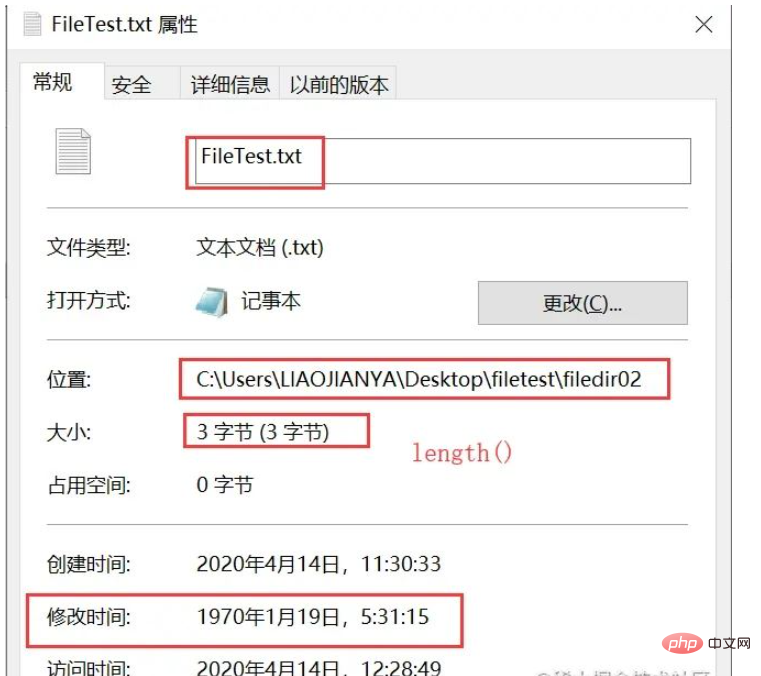
The File class represents platform-independent files and directories under the java.io package. File can create, delete, and rename files and directories, but it cannot access the file content itself. If you need to access the content, you need to access it through the input/output stream.
The File class can create a File instance using a file path string. The path can be either an absolute path or a relative path. Generally, the relative path is specified by the system property user.dir, which is the path where the Java VM is located.
/**
* Creates a new <code>File</code> instance by converting the given
* pathname string into an abstract pathname. If the given string is
* the empty string, then the result is the empty abstract pathname.
*
* @param pathname A pathname string
* @throws NullPointerException
* If the <code>pathname</code> argument is <code>null</code>
*/
public File(String pathname) {
if (pathname == null) {
throw new NullPointerException();
}
this.path = fs.normalize(pathname);
this.prefixLength = fs.prefixLength(this.path);
} public boolean setWritable(boolean writable) {
return setWritable(writable, true);
}public boolean setReadable(boolean readable): 底层实现是:通过setReadable(readable, true)实现,默认是仅适用于文件或目录所有者。
public boolean setReadable(boolean readable) {
return setReadable(readable, true);
}public boolean setExecutable(boolean executable, boolean ownerOnly):执行权限设置,executable如果为true,允许执行访问权限;如果为false,执行访问权限是不允许的。ownerOnly如果为true,则执行访问权限仅适用于所有者;否则它适用于所有人。
public boolean setExecutable(boolean executable): 底层实现是:通过setExecutable(executable, true)实现,默认是仅适用于文件或目录所有者。
public boolean setExecutable(boolean executable) {
return setExecutable(executable, true);
}public static File[] listRoots():列出系统所有的根路径,可以直接通过File类进行调用。
public long getTotalSpace():返回总空间大小,默认单位为字节。
public long getFreeSpace():Returns the number of unallocated bytes in the partition,返回未被分配空间大小,默认单位为字节。
public long getUsableSpace():Returns the number of bytes available to this virtual machine on the partition,返回可用空间大小,默认单位为字节。
public Path toPath():返回该File对象的Path对象。
public static File createTempFile(String prefix, String suffix) throws IOException:在默认存放临时文件目录中,创建一个临时空文件。可以直接使用File类来调用,使用给定前缀、系统生成的随机数以及给定后缀作为文件名。prefix至少3字节长。如果suffix设置为null,则默认后缀为.tmp。
public static File createTempFile(String prefix, String suffix, File directory):在指定的临时文件目录directort中,创建一个临时空文件。可以直接使用File类来调用,使用给定前缀、系统生成的随机数以及给定后缀作为文件名。prefix至少3字节长。如果suffix设置为null,则默认后缀为.tmp。
1)运行主类
package com.example.andya.demo;
import org.springframework.boot.SpringApplication;
import org.springframework.boot.autoconfigure.SpringBootApplication;
import java.io.File;
import java.io.IOException;
import java.net.URI;
import java.nio.file.Path;
import java.text.SimpleDateFormat;
@SpringBootApplication
public class DemoApplication {
public static void main(String[] args) throws IOException {
File file = new File("C:\\Users\\LIAOJIANYA\\Desktop\\filetest\\filedir02\\FileTest.txt");
System.out.println("getName(): " + file.getName());
System.out.println("getParent(): " + file.getParent());
System.out.println("getParentFile(): " + file.getParentFile());
System.out.println("getAbsolutePath(): " + file.getAbsolutePath());
System.out.println("getAbsoluteFile(): " + file.getAbsoluteFile());
System.out.println("getAbsoluteFile().getParent(): " + file.getAbsoluteFile().getParent());
System.out.println("getPath(): " + file.getPath());
System.out.println("isAbsolute(): " + file.isAbsolute());
System.out.println("getCanonicalPath(): " + file.getCanonicalPath());
System.out.println("getCanonicalFile(): " + file.getCanonicalFile());
System.out.println("canRead(): " + file.canRead());
System.out.println("canWrite(): " + file.canWrite());
System.out.println("canExecute(): " + file.canExecute());
System.out.println("exists(): " + file.exists());
System.out.println("isDirectory(): " + file.isDirectory());
System.out.println("isFile(): " + file.isFile());
System.out.println("isHidden(): " + file.isHidden());
System.out.println(file.setLastModified(1546275661));
SimpleDateFormat simpleDateFormat = new SimpleDateFormat("yyyy-MM-dd HH:mm:ss");
System.out.println("lastModified(): " + simpleDateFormat.format(file.lastModified()));
//在里面写了"123"这三个数字
System.out.println("length(): " + file.length());
File newFile01 = new File("C:\\Users\\LIAOJIANYA\\Desktop\\filetest\\filedir02\\FileTest1.txt");
newFile01.createNewFile();
newFile01.delete();
File newDir1 = new File("C:\\Users\\LIAOJIANYA\\Desktop\\filetest\\filedir02\\dir1");
System.out.println("mkdir(): " + newDir1.mkdir());
File newDir2 = new File("C:\\Users\\LIAOJIANYA\\Desktop\\filetest\\filedir02\\dir2\\dir2-1");
System.out.println("mkdirs(): " + newDir2.mkdirs());
String[] fileList = file.getParentFile().list();
System.out.println("========上一级目录下的所有文件和路径=========");
for (String fileName : fileList) {
System.out.println(fileName);
}
System.out.println("file重命名:" + file.renameTo(new File("C:\\Users\\LIAOJIANYA\\Desktop\\filetest\\filedir02\\FileTest.txt")));
System.out.println("========上一级目录下的所有文件和目录=========");
File[] files = file.getParentFile().listFiles();
for (File fileName : files) {
System.out.println(fileName.getName());
}
System.out.println("canRead(): " + file.canRead());
//人为改为不可写
System.out.println("setWritable(): " + file.setWritable(false, false));
System.out.println("canWrite(): " + file.canWrite());
System.out.println("canExecute(): " + file.canExecute());
System.out.println("========相对路径=========");
//默认相对路径是user.dir即为当前工程所在位置
System.out.println("user.dir:" + System.getProperty("user.dir"));
File newFile = new File("test.txt");
System.out.println("newFile文件是否存在:" + newFile.exists());
newFile.createNewFile();
System.out.println("新建newFile文件后是否存在:" + newFile.exists() + ", 路径为:" + newFile.getAbsolutePath());
System.out.println("getName(): " + newFile.getName());
System.out.println("getParent(): " + newFile.getParent());
System.out.println("getParentFile(): " + newFile.getParentFile());
System.out.println("getAbsolutePath(): " + newFile.getAbsolutePath());
System.out.println("getAbsoluteFile(): " + newFile.getAbsoluteFile());
System.out.println("getAbsoluteFile().getParent(): " + newFile.getAbsoluteFile().getParent());
System.out.println("getPath(): " + newFile.getPath());
System.out.println("isAbsolute(): " + newFile.isAbsolute());
System.out.println("getCanonicalPath(): " + newFile.getCanonicalPath());
System.out.println("getCanonicalFile(): " + newFile.getCanonicalFile());
URI uri = newFile.toURI();
System.out.println("URI:" + uri.toString());
File[] listRoots = File.listRoots();
System.out.println("========系统根目录下的所有文件和路径=========");
for (File root : listRoots) {
System.out.println(root);
}
System.out.println("getTotalSpace(): " + file.getTotalSpace()/1024/1024/1024 + " G");
System.out.println("getFreeSpace(): " + file.getFreeSpace()/1024/1024/1024 + " G");
System.out.println("getUsableSpace(): " + file.getUsableSpace()/1024/1024/1024 + " G");
Path path = file.toPath();
System.out.println("Path: " + path);
SpringApplication.run(DemoApplication.class, args);
}
}2)运行结果:
getName(): FileTest.txt getParent(): C:\Users\LIAOJIANYA\Desktop\filetest\filedir02 getParentFile(): C:\Users\LIAOJIANYA\Desktop\filetest\filedir02 getAbsolutePath(): C:\Users\LIAOJIANYA\Desktop\filetest\filedir02\FileTest.txt getAbsoluteFile(): C:\Users\LIAOJIANYA\Desktop\filetest\filedir02\FileTest.txt getAbsoluteFile().getParent(): C:\Users\LIAOJIANYA\Desktop\filetest\filedir02 getPath(): C:\Users\LIAOJIANYA\Desktop\filetest\filedir02\FileTest.txt isAbsolute(): true getCanonicalPath(): C:\Users\LIAOJIANYA\Desktop\filetest\filedir02\FileTest.txt getCanonicalFile(): C:\Users\LIAOJIANYA\Desktop\filetest\filedir02\FileTest.txt canRead(): true canWrite(): false canExecute(): true exists(): true isDirectory(): false isFile(): true isHidden(): false true lastModified(): 1970-01-19 05:31:15 length(): 3 mkdir(): false mkdirs(): false ========上一级目录下的所有文件和路径========= dir1 dir2 FileTest.txt file重命名:true ========上一级目录下的所有文件和目录========= dir1 dir2 FileTest.txt canRead(): true setWritable(): true canWrite(): false canExecute(): true ========相对路径========= user.dir:C:\DATA\selfcode newFile文件是否存在:true 新建newFile文件后是否存在:true, 路径为:C:\DATA\selfcode\test.txt getName(): test.txt getParent(): null getParentFile(): null getAbsolutePath(): C:\DATA\selfcode\test.txt getAbsoluteFile(): C:\DATA\selfcode\test.txt getAbsoluteFile().getParent(): C:\DATA\selfcode getPath(): test.txt isAbsolute(): false getCanonicalPath(): C:\DATA\selfcode\test.txt getCanonicalFile(): C:\DATA\selfcode\test.txt URI:file:/C:/DATA/selfcode/test.txt ========系统根目录下的所有文件和路径========= C:\ getTotalSpace(): 237 G getFreeSpace(): 41 G getUsableSpace(): 41 G Path: C:\Users\LIAOJIANYA\Desktop\filetest\filedir02\FileTest.txt
3)结果的一些验证: a)文件长度以及修改时间

b)设置不可写后:

b)磁盘大小

c)user.dir路径

1)运行主类
File file2 = new File("C:\\Users\\LIAOJIANYA\\Desktop\\filetest\\filedir01");
File tmp01 = file2.createTempFile("tmp01", ".tmp");
File tmp02 = file2.createTempFile("tmp02", ".tmp", file2);
tmp02.deleteOnExit();
File tmp03 = File.createTempFile("tmp03", null);
System.out.println("tmp01: " + tmp01.getAbsolutePath());
System.out.println("tmp02: " + tmp02.getAbsolutePath());
System.out.println("tmp03: " + tmp03.getAbsolutePath());2)运行结果
tmp01: C:\Users\LIAOJI~1\AppData\Local\Temp\tmp01870328708927314810.tmp
tmp02: C:\Users\LIAOJIANYA\Desktop\filetest\filedir01\tmp023046960943790159256.tmp
tmp03: C:\Users\LIAOJI~1\AppData\Local\Temp\tmp032224782289258299121.tmp
3)查看结果:
a)默认临时文件存放地址:

b)指定临时文件存放地址:

其中,如果需求中需要创建一个临时文件,这个临时文件可能作为存储使用,但在程序运行结束后需要删除文件,可以使用deleteOnExit()方法。
public String[] list(FilenameFilter filter)方法的使用。 1)运行主类
public class DemoApplication {
public static void main(String[] args) {
File file = new File("C:\\Users\\LIAOJIANYA\\Desktop\\filetest\\filedir02\\");
String[] nameArr = file.list(((dir, name) -> name.endsWith(".doc")));
for (String name : nameArr) {
System.out.println(name);
}
}
}2)运行结果:
文件01.doc
3)验证:

其中,通过使用Lambda表达式,目标类型为FilenameFilter实现文件过滤,上面过滤了以.doc结尾的文件。
The above is the detailed content of How to use File class methods in Java?. For more information, please follow other related articles on the PHP Chinese website!




